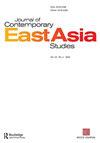China’s authoritarian path to development: is democratization possible?, by Liang Tang, Abingdon, Routledge, 2017, 263pp., ISBN: 978-1-138-01647-7
IF 1.4
Q1 AREA STUDIES
引用次数: 1
Abstract
This book attempts to explain why political reforms in China lag behind the country’s remarkable socioeconomic transformation which has been underway since reform and opening up. Despite consistent scholarly attention both in China and abroad, there appears to be no easy answer to the above conundrum. The author, an excellent political scientist now with the School of Political Science at Waseda University, analyses the dynamics of China’s political system not only through the lens of Western political research approaches, but also in the context of China’s unique historical and cultural experience. After receiving formal training in Orthodox Marxism political theory and history of the Chinese Communist Party (CCP) at Beijing University, Dr Tang moved to Japan where he studied Western Political Theory. In his recent monograph, the author poses a question of why, despite all the rapid social and economic changes, the CCP has maintained its monopoly on political power. Furthermore, considering the bigger picture, the author seeks to understand the reality of China’s long and winding road to democracy. On the whole, the author argues in favor of analyzing Contemporary Chinese Politics under the framework of Western theories of democracy, with particular focus on Huntington’s model of the third wave of democratization. Simultaneously, Dr Tang emphasizes the necessity for studying the “preconditions” for China’s democratization. First, unlike traditional theories of democratization (which distinguish between two stages of “transition” and “consolidation”), the author proposes to add a new “pretransition” stage which he labels “a foundation-building stage for democratization”, thus emphasizing gradual changes in the process of democratization (page 17). Second, the author considers the effectiveness of China’s “authoritarian path of modernization”, arguing that it lays the foundation for subsequent democratic soft-landing and democratic consolidation (p. 17). Third, the author sets out to explore the phenomenon of “authoritarian transmutation”, the growth of civil society and its implications for the Chinese democracy movement (p. 18). The book consists of nine chapters (including the Introduction and the Conclusion). In Part I (Chapters 1 and 2), the author discusses China’s political institutions as a means of modernization. The focus here is on the relationship between the one-party system and China’s authoritarian developmentalism. The author analyses the CCP’s control over the military, state agencies, and social actors, arguing that the substitution of Mao’s era dogmatic socialism with pragmatism led to a series of legislative, administrative, and judiciary reforms, which, in turn, resulted in an increase in transparency and citizen participation. Part II (Chapters 3, 4, and 5) discusses the Chinese government’s strategy on economic, political, and social reforms. With regard to economic development strategy, the author discusses (1) the circumstances under which economic development became top priority, (2) social tensions and social conflicts associated with economic development, and (3) modifications in economic development arrangements. Chapter 4 focuses on political reforms. The author perceives China’s political reforms as an interplay of “political leadership, specific reform programs, and reform outcomes” (p. 123). Further, the author explains how the Chinese government promotes a “Chinese-style democracy” (an approach based on cultural relativism), concluding that “ongoing economic reform, government reform, limited adoption of democratic mechanisms in the policy process, and the bottom-up demand for democratization中国的威权发展道路:民主化可能吗?,作者:梁唐,阿宾顿,劳特利奇,2017263页。,ISBN:978-1-138-01647-7
这本书试图解释为什么中国的政治改革落后于改革开放以来中国显著的社会经济转型。尽管国内外学术界一直关注这一问题,但上述难题似乎没有简单的答案。作者是一位杰出的政治学家,现就职于早稻田大学政治学院。他不仅从西方政治研究方法的角度,而且从中国独特的历史文化经验的背景下,分析了中国政治制度的动态。在北京大学接受正统马克思主义政治理论和中国共产党历史的正式培训后,唐博士移居日本,学习西方政治理论。在他最近的专著中,作者提出了一个问题,即为什么尽管社会和经济发生了快速变化,中国共产党仍然保持着对政治权力的垄断。此外,从更大的角度来看,作者试图了解中国漫长而曲折的民主之路的现实。总的来说,作者主张在西方民主理论的框架下分析当代中国政治,特别是亨廷顿的第三次民主化模式。同时,唐强调了研究中国民主化的“先决条件”的必要性。首先,与传统的民主化理论(区分“过渡”和“巩固”两个阶段)不同,作者建议增加一个新的“过渡前”阶段,他称之为“民主化的基础建设阶段”,从而强调民主化过程中的渐进变化(第17页)。其次,作者认为中国“威权现代化道路”的有效性,认为它为随后的民主软着陆和民主巩固奠定了基础(第17页)。第三,作者着手探讨“威权嬗变”现象、公民社会的成长及其对中国民主运动的启示(第18页)。本书共分九章(包括引言和结语)。在第一部分(第一章和第二章)中,作者讨论了作为现代化手段的中国政治制度。这里的重点是一党制与中国威权发展主义之间的关系。作者分析了中国共产党对军队、国家机构和社会行动者的控制,认为用实用主义取代毛时代的教条主义社会主义导致了一系列立法、行政和司法改革,进而提高了透明度和公民参与度。第二部分(第三章、第四章和第五章)讨论了中国政府在经济、政治和社会改革方面的战略。关于经济发展战略,作者讨论了(1)经济发展成为首要任务的情况,(2)与经济发展相关的社会紧张和社会冲突,以及(3)经济发展安排的修改。第四章着重于政治改革。作者认为中国的政治改革是“政治领导力、具体改革方案和改革成果”的相互作用(第123页)。此外,作者解释了中国政府如何促进“中国式民主”(一种基于文化相对主义的方法),得出的结论是“正在进行的经济改革、政府改革、在政策过程中有限地采用民主机制,以及自下而上的民主化需求
本文章由计算机程序翻译,如有差异,请以英文原文为准。
求助全文
约1分钟内获得全文
求助全文
来源期刊

Journal of Contemporary East Asia Studies
Social Sciences-Cultural Studies
CiteScore
2.50
自引率
0.00%
发文量
10
审稿时长
6 weeks
 求助内容:
求助内容: 应助结果提醒方式:
应助结果提醒方式:


